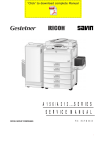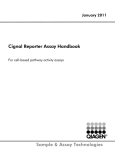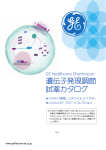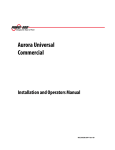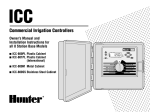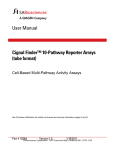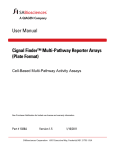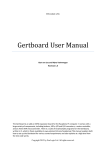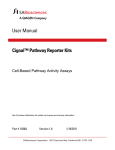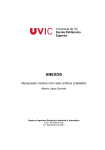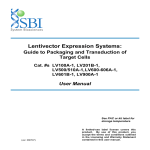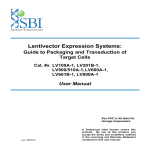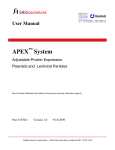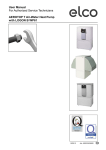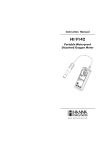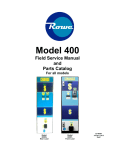Download Cignal Lenti Reporter User Manual
Transcript
August 2012 Cignal Lenti Reporter Handbook For lentiviral-based cell signaling activity assays Sample & Assay Technologies QIAGEN Sample and Assay Technologies QIAGEN is the leading provider of innovative sample and assay technologies, enabling the isolation and detection of contents of any biological sample. Our advanced, high-quality products and services ensure success from sample to result. QIAGEN sets standards in: Purification of DNA, RNA, and proteins Nucleic acid and protein assays microRNA research and RNAi Automation of sample and assay technologies Our mission is to enable you to achieve outstanding success and breakthroughs. For more information, visit www.qiagen.com. Product Use Limitations Cignal Lenti Reporter Assays are intended for molecular biology applications. These products are not intended for the diagnosis, prevention, or treatment of a disease. CONTENTS I. Introduction 4 II. Product Contents and Descriptions 7 A. Contents 7 B. Description 8 C. Production and Titration of Cignal Lentiviral Particles 9 D. Biosafety Features of Cignal Lentiviral Particles 10 E. Safety Guidelines 10 III. Cignal Lenti Reporter Controls 11 IV. Additional Materials Required 13 V. Protocol 14 A. Before You Begin 14 B. Brief Protocol 16 C. Detailed Protocol 17 VI. Frequently Asked Questions 20 Appendix: Troubleshooting and Cignal Lenti Reporter Products 22 Ordering information 25 I. Introduction Lentiviral particles have been shown to be the most effective vehicle for transferring and expressing reporter constructs in almost any mammalian cell, including non-dividing cells, primary cells, stem cells, differentiated cells, and difficult-to-transfect cell lines. Cignal Lenti Reporter Assays are ready-to-transduce, replication incompetent, HIVbased, VSV-G pseudotyped lentiviral particles. Cignal lentiviral reporter particles are designed for accurate, sensitive and quantitative assessment of the activation of signal transduction pathways. These lentiviral particles express inducible reporter constructs that encode a reporter gene under the control of a basal promoter element (TATA box) joined to tandem repeats of a specific transcriptional response element (TRE). Transcription factor activity can serve as an indicator for the intracellular status of many signal transduction pathways. Our constructs are specifically engineered for measuring changes in activity (both increases and decreases) of these signaling pathways. Each Cignal Lenti Reporter Assay is available with either luciferase or GFP as a reporter gene. Cignal Lenti Reporter Assays are valuable tools for deciphering gene function, as well as determining the mechanism of action of proteins, peptides, ligands, and small molecule compounds in cells that are not amenable to transfection. The Cignal Lenti firefly luciferase reporter encodes for the mammalian codon-optimized, non-secreted form of the firefly luciferase gene, carrying a protein-destabilizing sequence. Cells rapidly degrade the destabilized form of the firefly luciferase protein and hence the background luciferase activity (noise level) is greatly reduced. Due to low background activity, the magnitude of the response that can be measured (signal to noise ratio) as well as the speed of measuring changes in transcription are enhanced. The Cignal Lenti luciferase reporter assays provide outstanding reproducibility, sensitivity, specificity, and signal to noise ratio. They are extremely useful for carrying out endpoint pathway regulation assays. The Cignal Lenti (GFP) Reporter assay enables you to monitor the dynamics of pathway activation on living cells with single cell resolution. The Cignal Lenti GFP reporter constructs utilizes an improved version of the green fluorescent protein gene. This GFP expression cassette has been codon optimized to maximize mammalian cell expression and also utilizes an optimized Kozak sequence to increase translation efficiency. The synthetic GFP is an ideal fluorescent reporter, providing high-level fluorescence and minimal cytotoxicity. Moreover, the synthetic GFP gene is resistant to photobleaching. In addition, most consensus sequences for transcription factor binding have been removed from the synthetic GFP gene in order to minimize aberrant transcription and improve the reliability of the GFP as an accurate reporter. GFP has an excitation wavelength of 482 nm and an emission wavelength of 502 nm. GFP can be detected using common fluorescence filter sets or standard FACS settings as used for EGFP and FITC. 4 Benefits of Cignal Lenti Reporter Assays • Ready to transduce: Delivered as transduction-ready lentiviral particles, eliminating any need to construct and amplify lentivirus. • Transduce any cell type: Transduce virtually any cell type, including non-dividing cells, stem cells, and differentiated cells. • Wide application: Can be used for transient experiments as well as for developing stable pathway sensor cell for a specific cell signaling pathway, using either luciferase or GFP reporter gene technology. • Minimal cellular stress: Lentiviral reporter construct delivery method does not produce the non-specific cellular stress responses associated with chemical or electroporation-based transfection methods. 5 Figure 1: Overview of Cignal Lenti Pathway Reporter Applications. The Cignal Lenti Reporter Assays are ready for transduction right out of the box. There is no need to generate or propagate lentivirus in your laboratory. These vectors are useful for transient transduction studies in difficult to transfect cells or for pathway sensor cell line generation. 6 II. Product Contents and Descriptions A. Contents Table 1: Cignal Lenti Reporter Product Specifications Component Lenti Reporter – 1 tube Lenti Reporter – 8 tubes Specification Ready-to-transduce transcription factorresponsive lentiviral reporter Ready-to-transduce transcription factorresponsive lentiviral reporter Lentivirus Concentration (total volume) ≥ 0.8 ×107 TU/ml (250 µl) ≥ 0.8 ×107 TU/ml (2000 µl) Note: The exact titer of each Cignal Lentivirus preparation is reported on the Certificate of Analysis. Important: We recommend the use of Cignal Lenti Negative Control and Cignal Lenti Positive Control along with Cignal Lenti Reporter for better interpretation of results (for more details about Cignal Lenti Controls see page 11). 7 B. Description: Cignal Lenti Reporter Assay: Cignal Lenti Reporter Assays are delivered as ready-totransduce lentiviral particles expressing a transcription factor-responsive reporter gene (firefly luciferase or GFP) under the control of a basal promoter element (TATA box) joined to tandem repeats of a specific Transcriptional Response Element (TRE). A schematic of the transfer vector used to generate the Cignal Lentiviruses is shown in Figure 2. Cignal Lenti Reporter Assays monitor both increases and decreases in the activity of a key transcription factor, which is a downstream target of a specific signaling pathway. Figure 2: Schematic of lentiviral vector used to generate Cignal Lenti Reporter Assays. pCignal Lenti-TRE-Reporter gene encodes the inducible transcription factorresponsive construct expressing firefly luciferase or GFP as a reporter gene. The important features of the vector are described in the table below. 8 Feature RSV-5’ LTR; Hybrid Rous sarcoma Virus (RSV) enhancer/promoter-U5 long terminal repeat Psi; Packaging signal RRE; Rev response element cppt; Central polypurine tract Function Permits viral packaging and reverse transcription of viral mRNA Allow viral packaging Involved in packaging of viral transcript Involved in nuclear translocation and integration of transduced viral genome Allow quantification of transcription Permits high-level expression of the mammalian selection marker (puromycin) Can be used for mammalian selection Modified 3’LTR that allows viral packaging but self inactivates the 5’LTR for biosafety purpose. The element also contains a polyadenylation signal for efficient transcription termination Origin of DNA replication for bacteriophage f1 Allows selection of the plasmid in E.coli Permits regulation of reporter gene expression by a specific transcription factor Act as an minimal promoter Reporter gene (firefly luciferase or GFP) hPGK; human phosphoglycerate kinase eukaryotic promoter PuroR; puromycin resistance gene SIN/3’LTR; 3’ self inactivating long terminal repeat f1 ori; f1 origin of replication AmpR; ampicillin resistance gene TRE; Transcription response element TATA box C. Production and Titration of Cignal Lentiviral Particles The infectious, replication-incompetent pseudotyped Cignal Lentiviral particles were produced by cotransfecting specific Cignal Lentivector (Fig. 2) along with plasmids expressing packaging proteins (using VSV-G as an envelope protein) into HEK293T cells. Following cotransfection, we collected the media containing the pseudoviral particles was collected, centrifuged at 1250 rpm for 5 minutes, and filtered through 0.45 µm filter. The resultant lentiviruses were aliquoted and stored at -80°C. The lentiviral particles were titered by determining the number of antibiotic resistant cells (colonies) that arise after transduction and puromycin selection of HT-1080 cells. The exact titer of Cignal Lentiviral particles (reporter, negative and positive controls) will vary for different lots and are provided on the certificate of analysis included in each shipment. 9 D. Biosafety Features of Cignal Lentiviral Particles The Cignal Lentiviral particles have numerous biosafety features, which include: • A deletion in the promoter/enhancer region of the U3 portion of 3'LTR ensures selfinactivation of the lentiviral construct after transduction and integration into genomic DNA of target cells. • The Cignal Lentivector and plasmids expressing packaging proteins contain no significant areas of homology and thereby minimizing their chance for recombination. • None of the HIV-1 genes (gag, pol, rev) will be expressed in transduced cells, as they are expressed from packaging plasmids lacking packaging signal. Therefore, the lentiviral particles that are generated are replication-incompetent. • No virulence genes (∆vpr, vif, vpu and nef) are present in the Cignal Lentivector so Lentiviral particles will carry only a copy of reporter gene of interest. E. Safety Guidelines Although the Cignal lentiviral particles are replication incompetent, it is highly recommended that they be treated as Risk Group Level 2 (RGL-2) organisms. Follow all published RGL-2 guidelines for handling and waste decontamination. Details on requirements for creating a BSL-2 work environment are available in the U.S. Department of Health and Human Services publication Biosafety in Microbiological & Biomedical Laboratories, 4th 5th edition (http://www.cdc.gov/biosafety/publications/bmbl5/). You should also consult the health and safety guidelines and officers at your institution regarding use and handling of the lentiviral system. While working with Cignal Lenti Reporters, we also recommend following standard safety practices: • Wear double gloves and lab coat at all times. • Perform work in a Class II Biosafety Cabinet (BSC) and post biohazard warning signs. • Minimize splashes or aerosols with careful pipeting. • Autoclave all biological wastes and decontaminate before disposal. 10 III. Cignal Lenti Reporter Controls Control Positive Control (GFP) Variant ID for Catalog No 336891 CLS-PCG Positive Control (RFP) New CLS-PCR Negative Control (GFP) CLS-NCG Negative Control (Firefly Luciferase) CMV-Renilla Control CLS-NCL CLS-RCL Description Concentration And Volume Easily measure transduction efficiency and optimize transduction conditions with Green Fluorescent Protein ≥ 0.8 ×107TU/ml; 250 µl per tube Easily measure transduction efficiency and optimize transduction conditions with Red Fluorescent Protein ≥ 0.8 ×107TU/ml; 250 µl per tube Establish the specificity of any treatment effects and determine background GFP fluorescence ≥ 0.8 ×107TU/ml; 250 µl per tube Establish the specificity of any treatment effects and determine background firefly luciferase activity ≥ 0.8 ×107TU/ml; 250 µl per tube Serves as an internal control for normalization in dualluciferase assay format, providing more accurate interpretation of results ≥ 0.8 ×107TU/ml; 250 µl per tube TK-Renilla Control (luc) New CLS-TKL Serves as an internal control for normalization in dualluciferase assay format, providing more accurate interpretation of results ≥ 0.8 ×107TU/ml; 250 µl per tube CMV-Renilla Control (Hygromycin) New CLS-RHL For generating stable cell lines this construct serves as an internal control for normalization in dualluciferase assay format ≥ 0.8 ×107TU/ml; 250 µl per tube Positive Control (luc) CLS-PCL Measure transduction efficiency and serve as positive control for firefly luciferase assay ≥ 0.8 ×107TU/ml; 250 µl per tube Description of Cignal Lenti Reporter Controls: 1. Cignal Lenti Negative control: The Cignal Lenti negative controls are ready to transduce lentiviral particles expressing firefly luciferase or GFP under the control of a basal promoter element (TATA box), without any additional transcriptional response elements (Figure 3a). The negative control is critical to establishing the specificity of any treatment effects and determining background reporter activity. 11 2. Cignal Lenti Positive control: The Cignal Lenti positive controls are ready to transduce lentiviral particles constitutively expressing either firefly luciferase or GFP (Figure 3b), The Cignal Lenti positive control (GFP) is necessary for visual confirmation of transduction. It is also useful for transduction optimization studies. GFP has an excitation wavelength of 482 nm and an emission wavelength of 502 nm. GFP can be detected using common fluorescence filter sets or standard FACS settings as used for EGFP and FITC. 3. Cignal Lenti Renilla control (Rluc): The Cignal Lenti Renilla control is a preparation of ready to transduce lentiviral particles constitutively expressing Renilla luciferase (Figure 3b), The Cignal Lenti Renilla control (Rluc) serves as an internal control when performing dual-luciferase reporter assays. The Cignal Lenti Renilla control can be helpful in overcoming technical variability and obtain more reliable data. a. b. Figure 3: Schematic of lentiviral vector used to generate Cignal Lenti Reporter controls. (a) pCignal Lenti-minP-Reporter gene contains a non-inducible firefly luciferase or GFP expression cassette. (b) pCignal Lenti-CMV-Reporter gene contains a constitutive firefly luciferase or GFP or Renilla luciferase expression cassette. The 12 important features of the vectors are the same as those described on page 9 for the pCignal Lenti-TRE-Reporter gene vectors. IV. Additional Materials Required: • Mammalian cells cultured in the appropriate growth medium • Cell culture medium and cell culture supplies • Biosafety Level-2 (BSL-2) equipment and work environment • 96-well tissue culture plates • Multi-channel pipettor and pipettor reservoirs • Hemacytometer • • SureENTRY™ Transduction Reagent Reagent (Catalog Number 336921) Cignal Lenti Negative Control o For firefly luciferase reporter studies: cat# CLS-NCL o For GFP reporter studies: cat# CLS-NCG • Cignal Lenti Positive Control o For firefly luciferase reporter studies: CLS-PCL o For GFP reporter studies: CLS-PCG • Cignal Lenti Renilla Control (For dual-luciferase reporter assay format; cat# CLS-RCL or CLS-TKL or CLS-RHL) • Cell culture Growth medium: (DMEM + 10% FBS + 1 x NEAA + 1 x Pen/Strep) • Puromycin (For generating stable pathway sensor cell lines; Sigma; cat# p8833) • Firefly Luciferase Assay System o Luciferase Assay System (Promega, cat# E1500) o Steady-Glo® Luciferase Assay System (Promega, cat# E2510) o Bright-Glo™ Luciferase Assay System (Promega, cat# E2610) • Dual-Luciferase® Assay System o Dual-Luciferase® Reporter Assay System (Promega, cat# E1910) o Dual-Glo® Luciferase Assay System (Promega, cat# E2920) • 96-well white opaque flat bottom microtiter plate • Luminometer 13 • FACS, flow cytometer, fluorescent microscope, or fluorometer V. Protocol: A. Before you begin: Cell type selection: The Cignal lentiviral particles are pseudotyped with the VSV-G envelope protein. This allows efficient transduction of lentiviral particles, containing the transcription factor responsive reporter gene (firefly luciferase or GFP), into most mammalian cells. When working with a cell type for the first time, it is recommended to optimize the conditions for efficient transduction. Optimization of conditions for efficient transduction: The sensitivity of the Cignal Lenti Reporter Assay depends on the transduction efficiency. The transduction efficiency, in turn, primarily depends upon the cell type being transduced. Therefore, it is very important to optimize the transduction conditions for each cell type under study. Variables to consider, when optimizing the transduction conditions include Multiplicity of Infection (MOI), concentration of SureENTRY™ Transduction Reagent used, time of assay development and the cell density. The Cignal Lenti positive control (GFP) (Cat # CLS-PCG) can be used for determining the optimal transduction conditions. Multiplicity of Infection (MOI): The transduction efficiency of Cignal Lenti reporters varies significantly for different cell type. It is important to determine the Multiplicity of Infection (MOI), which is the number of transducing lentiviral particles per cell, required to get desired transduction efficiency for each new cell type. The MOI is typically adjusted by increasing or decreasing the amount of virus added per well to a series of wells containing the same number of cells. We recommend testing the Cignal Lenti Positive Control (CLS-PCG) at an MOI of 5, 10, and 50 (each MOI in triplicate), in order to establish the optimal MOI for each cell type to be studied. To calculate: Multiplicity of Infection (MOI) = Number of transducing units (TU) deposited in a well Number of target cells present in that well. Total transducing units needed per well (TU) = (Total number of cells per well) x (Desired MOI) Total mL of lentiviral particles to add to each well = Total TU needed per well TU/mL reported on Certificate of Analysis We have found that some commonly used cancer cell lines (e.g., HT1080, HEK293 and HepG2) can be effectively transduced by lentivectors using 10 to 25 MOI, however, 14 some cell types (like primary cells) are more resistant to transduction and efficient transduction of these cell types may require a higher MOI (around 50). Importantly, it has been reported in the literature that the VSV-G pseudotyped lentiviruses can be used to transduce stem cells, primary cells (HUVEC, keratinocytes, bone marrow, adipose) and many other cell types, including neurons, endothelial, retinal, pancreatic, skin fibroblasts, macrophages, etc. Concentration of SureENTRY™ Transduction Reagent: SureENTRY Transduction Reagent is a small, positively charged molecule that binds to cell surfaces, neutralizes surface charge, increases binding between pseudoviral capsid and the cellular membrane; and greatly enhances transduction efficiency. The optimal concentration of SureENTRY Transduction Reagent depends on cell type and may need to be determined experimentally (usually in the range of 4-8 µg/ml). SureENTRY Transduction Reagent can be toxic to terminally differentiated neurons and dendritic cells. In situations like this, titration of SureENTRY Transduction Reagent using 2, 4, 6, 8 µg/ml will have to be done to determine the highest nontoxic concentration that can be used. If toxicity is a big problem, then cells can be transduced in the absence of SureENTRY Transduction Reagent but the MOI will have to be increased. Time of assay development: It is recommended to wait a minimum of 48 hours after lentiviral transduction to allow the reporter gene present in the lentiviral vector to reverse transcribe and integrate into the chromosomal DNA. In most cases, expression of reporter gene can be measured 72 hours after transduction (transient transduction). However, some cell types show a delay in expressing reporter genes. In these cases we recommend development of reporter assay at about 96 hours after transduction. Transient transduction or stable cell generation: Cignal Lenti Reporter Assays work very well for transient transduction experiments. In such transient pathway activation studies, reporter gene expression is typically measured 72 to 96 hours after transduction. At that time, Cignal reporter constructs are integrated into the genomic DNA. These cells can be further cultured under puromycin selection to generate stably transduced signaling pathway sensor cell lines. Some cells lines (like primary cell lines) only express the Cignal reporter construct in 10-30% of cells, even when transduced at high MOI’s. For these “difficult-to-transduce” cells, it is important to select the cells stably expressing the reporter gene by puromycin selection for an additional two weeks prior to carrying out pathway activation studies. 3. Optimization of assay condition: The response rate in the Cignal Lenti Reporter Assay depends on the assay conditions (conditions of the experimental treatment). To obtain maximum response given by any stimulus, perform dosing and time-course studies. The optimal amount of stimulus and the time of treatment must be obtained empirically for each experiment (see different protocols for our recommendations). 4. Important recommendations for best results: 1. Perform all transduction in triplicate to minimize variability among treatment groups. 2. Include positive and negative controls in each experiment to obtain reliable results. 15 3. Take care to always seed the same number of cells in each well, in order to maximize the reproducibility of your experiment. 4. Serum induces various signaling pathways, leading to cross-talk and high background. Therefore, use reduced amounts of serum (0.5%) in the assay medium during the experimental treatment to minimize these serum effects. B. Brief Protocol: Day 1: Seed cells Day 2: Remove growth medium and add appropriate amount of Cignal Lenti Reporter (typically 10 to 50 MOI)* and SureENTRY Transduction Reagent **. Day 3: Remove Cignal Lenti Reporter suspension. Replace with growth medium. Depending upon experimental design, transfect with test siRNA/shRNA plasmids or expression vectors Day 4 or 5: Depending upon experimental design, treat with test proteins, peptides, or compounds Day 5 or 6: Analyze pathway reporter gene expression (luciferase or GFP) * We recommend using the Cignal Lenti Positive Control (cat. no. CLS-PCG) in an initial experiment, to determine the optimal MOI for the target cells being studied. ** SureENTRY Transduction Reagent enhances lentiviral transduction efficiency in most cell types. 16 C. Detailed Protocol The following protocol is designed to transduce HEK293 cells using Cignal Lenti Reporter Assays in a 96-well plate format. Cignal Lenti Reporters Assays work well with other mammalian cells. If you are using plates or wells of different size, adjust the components in proportion to the surface area. This is just a general guideline; the optimal transduction conditions should be optimized according to the cell type and the study requirements. Read the protocol completely before starting the experiment. Day 1 1. Trypsinize 90% confluent HEK293 cells with trypsin-EDTA for 2-5 minutes at 37ºC to make cell suspension. Gently detach the cells from tissue culture dish with a pipette, mix with one volume of culture medium containing 10% fetal bovine serum, then centrifuge down, remove the supernatant, and suspend cells to 0.5-1 x 105 cells/ml in growth media. To ensure reproducible transduction results, it is important to determine the cell density with a hemacytometer. 2. Add 100 µl of resuspended cells (0.5-1×104 cells) in each well of 96-well plate. Triplicate wells for each lentiviral reporter, negative control and positive control should be used. 3. Incubate cells at 37°C overnight in a humidified 5% CO 2 incubator. Note: While determining the plating density, please consider that the growth rates of cells vary greatly and account for the length of time the cells will be growing before the assay development. Day 2 4. Remove medium from wells. To each well add 20 µl of Cignal lentiviral particles (Lenti reporter or Lenti negative control or Lenti positive control) and make up the total volume of 50 µl using growth medium without antibiotics (DMEM with 10% FBS, 0.1mM NEAA, 1mM Sodium pyruvate). In this particular case, add 30 µl of growth medium without antibiotics. 5. Add SureENTRY Transduction Reagent to a final concentration of 8 µg/ml in each well. Gently swirl the plate to mix. 6. Incubate 18-20 hours at 37°C in a humidified incubator in an atmosphere of 5% CO 2 . Note: SureENTRY Transduction Reagent enhances transduction of most cells; however, some cells like primary neurons are sensitive to SureENTRY Transduction Reagent. Do not add SureENTRY Transduction Reagent to these types of cells. If working with a cell 17 type for the first time, a SureENTRY Transduction Reagent control only well should be used to determine cell sensitivity. Important: When transducing Cignal lentiviral particles into a cell type for the first time, we suggest using either 10 or 50 MOI as a starting point to determine the optimal assay development conditions. Always include Cignal Lenti positive control (GFP) for determining transduction efficiency. Day 3 7. Remove the medium containing Cignal lentiviral particles from wells. Add 100 µl of fresh growth medium (DMEM with 10% FBS, 0.1mM NEAA, 1mM Sodium pyruvate, 100 U/ml penicillin and 100 µg/ml streptomycin) to each well. Day 5 8. Harvest the transduced cells and assay for the expression of the reporter gene. Important notes: 1. In most cell types the expression of reporter gene can be measured directly at about 72 hours after transduction (day 5 of the assay). However, some cell types show a delay in expressing reporter genes and in these cases we recommend development of reporter assay at about 96 hours after transduction (day 6 of the assay). 2. The luciferase assay can be developed by using either the Firefly Luciferase or DualLuciferase Reporter Assay Systems from Promega. Follow the manufacturer’s protocol for developing the assay. 3. The expression of the GFP reporter can be monitored via FACS, flow cytometry, fluorescent microscopy, or standard fluorometry. GFP has an excitation wavelength of 482 nm and an emission wavelength of 502 nm. GFP can be detected using common fluorescence filter sets or standard FACS settings as used for EGFP and FITC. 4. To determine the effect of siRNA/shRNA on a specific reporter or signaling pathway, we recommend doing transient transfection of siRNA/shRNA on day 3 of the assay. 5. To determine the effect of overexpression of a gene on a specific reporter or signaling pathway, we recommend doing the transient transfection of 100-200 ng of experimental vector and negative control vector 24 or 36 hours before the assay development. 6. To determine the effect of recombinant protein or small peptide on a specific reporter or signaling pathway, we recommend changing the cell medium to assay medium (Opti-MEM® containing 0.5% of fetal bovine serum, 1% NEAA, 100 U/ml 18 Penicillin and 100 µg/ml Streptomycin) and treating the transduced cells with 3 to 4 different concentration of recombinant protein or small peptide about 6 or 24 hours before the assay development. 7. To determine the effect of small chemicals on a specific reporter or signaling pathway, we recommend changing the cell medium to assay medium (Opti-MEM® containing 0.5% of fetal bovine serum, 1% NEAA, 100 U/ml Penicillin and 100 µg/ml Streptomycin) and treating the transduced cells with 3 to 4 different concentration of small chemicals for 6 to 24 hours before the assay development. 8. For the generation of stable cell line, on DAY 4 remove the growth medium and replace it with fresh growth medium that contains the appropriate amount of puromycin for selection of transduced cells. Replace medium with fresh, puromycincontaining medium every 3-4 days until resistant colonies can be identified (after selection). Pick a minimum of 5 puromycin-resistant colonies and expand each clone. Check each clone for its ability to sense the modulation of the activity of the specific transcription factor or signaling pathway. Use the most responsive clone for further studies. 9. To determine the appropriate amount of puromycin for selection of transduced target cells, perform the puromycin titration (kill curve) using the following guidelines: i. Plate 1.6 ×104 cells into wells of a 96-well plate with 120 µl fresh media. ii. The next day add 500–10,000 ng/ml of puromycin to selected wells. iii. Examine viability every 2 days. iv. Culture for 10–14 days. Replace the media containing puromycin every 3 days. v. The minimum concentration of puromycin that causes complete cell death after 3–5 days should be used for that cell type. 19 VI. Frequently Asked Questions: Q: How many cells can I transduce with the amount of Cignal Lenti Reporter Assays provided? A: The amount of cells that can be transduced depends upon your chosen target cells and how easily they are transduced. Primary or other difficult cells may require higher MOIs than cell lines. It is recommended to perform a limiting dilution titer on your target cells utilizing our Cignal Lenti positive control (cat# CLS-PCG) to determine the optimal amount of viral particles needed for your particular cell type. Q: How can I make sure that my cell type of interest can be transduced with Cignal Lentiviruses? A: The Cignal Lentiviruses are pseudotyped with VSV-G Protein, which is pantropic and allows the lenitivirus to interact with its target cell in a receptor-independent manner. This receptor-independent entry into the target cell likely involves endocytosis. Thereby, in theory, the lentivirus can transduce virtually any mammalian cell type. Also, lentivirus does not require a mitotic event for integration into the host cell genome. However, it is recommended to consult the literature or utilize our Cignal Lenti positive control (cat# CLS-PCG) to determine if your target cells of interest can be transduced with Cignal Lentiviruses. Q: Can Cignal Lentivirus particles be further propagated in the lab? A: No, Cignal Lentivectors are engineered for maximum biosafety, and are therefore replication incompetent. Genes for replication are not included in the packaged viral genome, and the lentiviral vector contains a self-inactivating 3'LTR. Q: Does the Cignal lentivirus produce any toxic viral genes? A: The Cignal Lentiviruses do not carry or express any viral genes and therefore have no associated toxicity issues. Q: How labile is the Cignal lentivirus? A: The lentivirus is sensitive to temperature (65°C or higher), hypo-osmolarity, 10% bleach, 70% ethanol, and detergents (Triton X-100, etc.). Q: How one can decontaminate lentiviral contaminated surfaces? A: Please follow CDC guidelines. We typically use 10% bleach to inactivate the virus. Q: What does transduction unit (TU) mean? 20 A: Transducing Units refer to the number of vector genomes that can infect, enter and integrate into a population of cells. Q: What precautions one should take while handling Cignal Lentiviruses? A: The Cignal Lentiviruses should be used in a BSL2 tissue culture cabinet using gloves and BSL2 tissue culture procedures. For any other troubleshooting or technical questions about the Cignal Lenti Reporters, please call one of our Technical Support representatives at 1-888-5033187 or 301-682-9200 or email at [email protected]. 21 Appendix: Troubleshooting and Cignal Lenti Reporter Products A. Reasons for inefficient transduction or low expression of Cignal Lenti Reporters Target cell type may be difficult to transduce: Optimize the transduction protocol (number of cell, SureENTRY Transduction Reagent concentration and MOI required for best transduction) and use higher MOI. In some cases, SureENTRY Transduction Reagent is toxic for target cells. Volume of Cignal lentiviral particles used is too high: Keep the volume as low as possible to achieve maximal adsorption of viral particles to the cells. The assay is performed too early: Usually the maximal expression of integrated transgene is expected to develop by 72 hours after infection, however, some cells showed delayed expression. Therefore, we suggest developing the assay at a later time, such as 96 hours. Inactivation of Cignal Lentiviral particles during storage: Store lentiviruses at – 80°C. and avoid freeze-thaw cycle. Cignal Lentiviral stock medium affects target cell growth: Dilute the stock medium or concentrate the pseudovirus by centrifugation to minimize the amount of stock medium added to the target cells. B. Reasons for no expression from Cignal Lenti positive control It might be any one of the reasons stated above OR CMV promoter is not functional in target cells: In certain cell types the CMV promoter is not functional. In these cases, one has to change the type of target cells or use lentivirus having a constitutively active promoter other than the CMV promoter. 22 Cignal Lenti Reporter Assays Pathway Transcription Factor luciferase Variant ID Amino Acid Deprivation New ATF4/ATF3/ATF2 CLS-5034L Androgen AR CLS-8019L Antioxidant Response Nrf2 & Nrf1 CLS-2020L ATF6 New ATF6 CLS-6031L C/EBP C/EBP CLS-001L cAMP/PKA CREB CLS-002L Cell Cycle E2F/DP1 CLS-003L EGR1 EGR1 CLS-5021L ER Stress CBF/NF-Y/YY1 CLS-9032L Heavy Metal Stress MTF1 CLS-2033L Hedgehog GLI CLS-3030L Hypoxia HIF-1 CLS-007L Interferon Regulation IRF1 CLS-4040L Type I Interferon STAT1/STAT2 CLS-008L Interferon Gamma STAT1/STAT1 CLS-009L KLF4 KLF4 CLS-1036L Liver X Receptor LXRa CLS-7041L MAPK/ERK Elk-1/SRF CLS-010L CLS-010G MAPK/JNK AP-1 CLS-011L CLS-011G MEF2 MEF2 CLS-4024L c-myc Myc/Max CLS-012L Nanog Nanog CLS-4037L NFκB NFκB CLS-013L CLS-013G Notch RBP-Jk CLS-014L CLS-014G Oct4 Oct4 CLS-7025L PI3K/AKT FOXO CLS-8022L PKC/Ca++ NFAT CLS-015L Retinoic Acid Receptor Retinoic Acid Receptor (RAR) CLS-016L Retinoid X Receptor RXR CLS-6044L SP1 SP1 CLS-3027L STAT3 STAT3 CLS-6028L TGFβ SMAD2/SMAD3/SMAD4 CLS-017L Vitamin D VDR CLS-9029L Wnt TCF/LEF CLS-018L Xenobiotic AhR CLS-9045L 23 GFP Variant ID CLS-002G CLS-018G Cignal Lenti Reporter Controls Variant ID for Catalog No 336891 Control Description Positive Control (GFP) CLS-PCG Easily measure transduction efficiency and optimize transduction conditions with Green Fluorescent Protein Positive Control (RFP) New CLS-PCR Easily measure transduction efficiency and optimize transduction conditions with Red Fluorescent Protein Negative Control (GFP) CLS-NCG Establish the specificity of any treatment effects and determine background GFP fluorescence Negative Control (Firefly Luciferase) CLS-NCL Establish the specificity of any treatment effects and determine background firefly luciferase activity CMV-Renilla Control CLS-RCL Serves as an internal control for normalization in dualluciferase assay format, providing more accurate interpretation of results TK-Renilla Control (luc) CLS-TKL Serves as an internal control for normalization in dualluciferase assay format, providing more accurate interpretation of results CMV-Renilla Control (Hygromycin) CLS-RHL For generating stable cell lines this construct serves as an internal control for normalization in dual-luciferase assay format Positive Control (luc) CLS-PCL Measure transduction efficiency and serve as positive control for firefly luciferase assay Cignal Finder Lenti 10-Pathway Reporter Arrays Product Name Components Concentration and Volume Cignal Finder Lenti Immune Response 10-Pathway Reporter Array Ready-to-transduce transcription factor-responsive lentiviral firefly luciferase pathway reporters (10 tubes total) + negative and positive controls (1 tube each) ≥ 0.8 ×107TU/ml; 250 µl of each reporter and control CLA-002L/336831 Cignal Finder Lenti Development 10-Pathway Reporter Array Ready-to-transduce transcription factor-responsive lentiviral firefly luciferase pathway reporters (10 tubes total) + negative and positive controls (1 tube each) ≥ 0.8 ×107TU/ml; 250 µl of each reporter and control CLA-003L/336831 24 Catalog Number Ordering Information Product Contents Cat. no. Cignal Lenti Reporter Assays Ready-to-transduce transcription factorresponsive lentiviral reporters in tube format Varies For up-to-date licensing information and product-specific disclaimers, see the respective QIAGEN kit handbook or user manual. QIAGEN kit handbooks and user manuals are available at www.qiagen.com or can be requested from QIAGEN Technical Services or your local distributor. 25 26 Trademarks: QIAGEN® (QIAGEN Group). Limited License Agreement Use of this product signifies the agreement of any purchaser or user of Cignal Lenti Reporter Assays to the following terms: 1. The Cignal Lenti Reporter Assays may be used solely in accordance with the Cignal Lenti Reporter Handbook and for use with components contained in the Kit only. QIAGEN grants no license under any of its intellectual property to use or incorporate the enclosed components of this Kit with any components not included within this Kit except as described in the Cignal Lenti Reporter Handbook and additional protocols available at www.qiagen.com. 2. Other than expressly stated licenses, QIAGEN makes no warranty that this Kit and/or its use(s) do not infringe the rights of third-parties. 3. This Kit and its components are licensed for one-time use and may not be reused, refurbished, or resold. 4. QIAGEN specifically disclaims any other licenses, expressed or implied other than those expressly stated. 5. The purchaser and user of the Kit agree not to take or permit anyone else to take any steps that could lead to or facilitate any acts prohibited above. QIAGEN may enforce the prohibitions of this Limited License Agreement in any Court, and shall recover all its investigative and Court costs, including attorney fees, in any action to enforce this Limited License Agreement or any of its intellectual property rights relating to the Kit and/or its components. For updated license terms, see www.qiagen.com. Firefly and/or Renilla Luciferase and Monster Green Limited Use Label License READ THIS FIRST BEFORE OPENING PRODUCT For research use only. The terms of the limited license conveyed with the purchase of this product are as follows: Researchers may use this product in their own research and they may transfer derivatives to others for such research use provided that at the time of transfer a copy of this label license is given to the recipients and the recipients agree to be bound by the conditions of this label license. Researchers shall have no right to modify or otherwise create variations of the nucleotide sequence of the luciferase gene or Monster Green® gene except that Researchers may: (1) clone heterologous DNA sequences at either or both ends of said luciferase or Monster Green® gene so as to create fused gene sequences provided that the coding sequence of the resulting luciferase or Monster Green gene has no more than four deoxynucleotides missing at the affected terminus when compared to the intact luciferase or Monster Green® gene sequence, and (2) insert and remove nucleic acid sequences in furtherance of splicing research predicated on the inactivation or reconstitution of the luminescent activity of the encoded luciferase. In addition, Researchers must do one of the following: (1) use luminescent assay reagents purchased from Promega Corporation for all determinations of luminescence activity resulting from the research use of this product and its derivatives; or, (2) contact Promega Corporation to obtain a license for the use of the product and its derivatives. No other use or transfer of this product or its derivatives is authorized without the express written consent of Promega Corporation including, without limitation, Commercial Use. Commercial Use means any and all uses of this product and derivatives by a party for monetary or other consideration and may include, but is not limited to use in: (1) product manufacture; and (2) to provide a service, information or data; and/or resale of the product or its derivatives, whether or not such product or derivatives are resold for use in research. With respect to such Commercial Use, or any diagnostic, therapeutic or prophylactic uses, please contact Promega Corporation for supply and licensing information. If the purchaser is not willing to accept the conditions of this limited use statement, SABiosciences is willing to accept the return of the unopened product and provide the purchaser with a full refund. However, in the event the product is opened, then the purchaser agrees to be bound by the conditions of this limited use statement. The above license relates to Promega Corporation patents and/or patent applications on improvements to the luciferase and Monster Green® gene. United States Patent No. 5,292,658 licensed from Millipore Corporation. Cignal™ Lenti Reporter Assay System Limited License. The purchaser of this product agrees to only use the lentiviral particles in this kit in cell-based reporter assays for in vivo and in vitro internal research. Use of this product for Commercial Purposes requires a license from Sigma-Aldrich Corporation. The purchase of this product conveys to the buyer the nontransferable right to use the purchased amount of the product and components of the product in research conducted by the buyer (whether the buyer is an academic or for-profit entity). The buyer cannot sell or otherwise transfer (a) this product (b) its components or (c) materials made using this product or its components to a third party, or otherwise use this product or its components or materials made using this product or its components for Commercial Purposes. Commercial Purposes means any activity by a party for consideration, but excludes not-for-profit core facilities providing services within their own research institutions at cost. This product is licensed under U.S. Pat. Nos. 5,817,491; 5,591,624; 5,716,832; 6,312,682; 6,669,936; 6,235,522; 6,924,123 and foreign equivalents from Oxford BioMedica (UK) Ltd., Oxford, UK, and is provided for use in academic and commercial in vitro and in vivo research for elucidating gene function, and for validating potential gene products and pathways for drug discovery and development, but excludes any use of LentiVector® technology for: creating transgenic birds for the purpose of producing useful or valuable proteins in the eggs of such transgenic birds, the delivery of gene therapies, and for commercial production of therapeutic, diagnostic or other commercial products not intended for research use where such products do not consist of or incorporate a lentiviral vector. Information about licenses for commercial uses excluded under this license is available from Oxford BioMedica (UK), Ltd., Medawar Center, Oxford Science Park, Oxford OX4 4GA UK [email protected] or BioMedica Inc., 11622 El Camino Real #100, San Diego CA 92130-2049 USA. LentiVector is a registered US and European Community trademark of Oxford BioMedica plc. Fluorescent Protein Limited License Statement This product is for internal non-commercial research use only. No rights are conveyed to modify or clone the gene encoding fluorescent protein contained in this product. The right to use this product specifically excludes the right to validate or screen compounds. For information on commercial licensing, contact Evrogen Licensing Department, email: [email protected]. Dual-Glo, Dual-Luciferase, Steady-Glo, Bright-Glo and Monster Green are trademarks of Promega Corporation. Opti-MEM is a registered trademark of Life Technologies. © 2012 QIAGEN, all rights reserved. www.qiagen.com Australia Orders 1-800-243-800 Fax 03-9840-9888 Technical 1-800-243-066 Austria Orders 0800-28-10-10 Fax 0800-28-10-19 Technical 0800-28-10-11 Belgium Orders 0800-79612 Fax 0800-79611 Technical 0800-79556 Brazil Orders 0800-557779 Fax 55-11-5079-4001 Technical 0800-557779 Canada Orders 800-572-9613 Fax 800-713-5951 Technical 800-DNA-PREP (800-362-7737) China Orders 86-21-3865-3865 Fax 86-21-3865-3965 Technical 800-988-0325 Denmark Orders 80-885945 Fax 80-885944 Technical 80-885942 Finland Orders 0800-914416 Fax 0800-914415 Technical 0800-914413 France Orders 01-60-920-926 Fax 01-60-920-925 Technical 01-60-920-930 Offers 01-60-920-928 Germany Orders 02103-29-12000 Fax 02103-29-22000 Technical 02103-29-12400 Hong Kong Orders 800 933 965 Fax 800 930 439 Technical 800 930 425 Ireland Orders 1800 555 049 Fax 1800 555 048 Technical 1800 555 061 Italy Orders 800-789-544 Fax 02-334304-826 Technical 800-787980 Japan Telephone 03-6890-7300 Fax 03-5547-0818 Technical 03-6890-7300 Korea (South) Orders 080-000-7146 Fax 02-2626-5703 Technical 080-000-7145 Luxembourg Orders 8002-2076 Fax 8002-2073 Technical 8002-2067 Mexico Orders 01-800-7742-639 Fax 01-800-1122-330 Technical 01-800-7742-436 The Netherlands Orders 0800-0229592 Fax 0800-0229593 Technical 0800-0229602 Norway Orders 800-18859 Fax 800-18817 Technical 800-18712 Singapore Orders 1800-742-4362 Fax 65-6854-8184 Technical 1800-742-4368 Spain Orders 91-630-7050 Fax 91-630-5145 Technical 91-630-7050 Sweden Orders 020-790282 Fax 020-790582 Technical 020-798328 Switzerland Orders 055-254-22-11 Fax 055-254-22-13 Technical 055-254-22-12 UK Orders 01293-422-911 Fax 01293-422-922 Technical 01293-422-999 USA Orders 800-426-8157 Fax 800-718-2056 Technical 800-DNA-PREP (800-362-7737) 1073762 08/2012 Sample & Assay Technologies





























